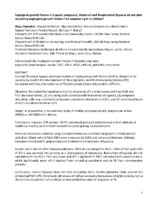Mostrar el registro sencillo del ítem
Maternal and fetoplacental hypoxia do not alter circulating angiogenic growth factors : the emperor's got no clothes?
| dc.contributor.author | Zamudio, Stacy | |
| dc.contributor.author | Williams, Shauna | |
| dc.contributor.author | Kovalenko, Olga | |
| dc.contributor.author | Borges, Marcus | |
| dc.contributor.author | Echalar, Lourdes | |
| dc.contributor.author | Torricos, Tatiana | |
| dc.contributor.author | Paiva, Priscilla | |
| dc.contributor.author | Illsley, Nicholas P | |
| dc.date.accessioned | 2016-10-03T16:38:20Z | |
| dc.date.available | 2016-10-03T16:38:20Z | |
| dc.date.issued | 2010 | |
| dc.identifier.uri | http://repositorio.umsa.bo/xmlui/handle/123456789/8128 | |
| dc.description.abstract | ABSTRACT. Context: Placental hypoxia alters production of angiogenic growth factors (AGFs), thought to be causally involved in the development of the pregnancy-specific disease preeclampsia (PE). Consistent with this, the incidence of PE is increased at high altitude (HA, >2700m). Objective. We tested the hypotheses that (1) circulating sFlt-1 is increased and free VEGF and PlGF decreased at HA, (2) circulating AGFs correlate with biomarkers of hypoxia, (3) peripheral circulating cells may contribute to hypoxia-associated alterations in AGFs, and (4) cord blood levels of AGFs are altered at HA or in PE. Design. A prospective, cross-sectional study of healthy and preeclamptic pregnancies at low (400m) vs. HA (3600m) in Bolivia. Participants. Subjects (170 normal, 39 PE) conceived, gestated and delivered at their altitude of residence. Healthy women had no conditions predisposing to preeclampsia. Methods: Blood was collected using standard techniques and those designed to inhibit platelet activation. Maternal and fetal AGFs were measured by ELISA and compared between altitudes, between normal and PE pregnancies and in relation to biomarkers of hypoxia. Results: AGFs did not differ between altitudes. >90% of circulating free VEGF, >30% of PlGF and >25% of sFlt-1 was secreted into samples as a consequence of hemostasis. Biomarkers of hypoxia did not correlate with the AGFs. PlGF was lower and sFlt-1 higher in PE. PlGF correlated with placental mass, whilst significantly more sFlt-1 derived from circulating peripheral cells in PE than normotensive patients. Conclusions. Chronic hypoxia does not alter circulating AGFs. Smaller placentas likely account for diminished PlGF in PE. Peripheral cell release of AGFs provoked by hemostasis is highly variable, hence clinical tests based AGFs are unlikely to have predictive value for diagnosis of PE. | es_ES |
| dc.language.iso | en | es_ES |
| dc.publisher | The Journal of Clinical Endocrinology & Metabolism | es_ES |
| dc.subject | HIPOXIA FETOPLACENTAL | es_ES |
| dc.subject | EMBARAZO | es_ES |
| dc.title | Maternal and fetoplacental hypoxia do not alter circulating angiogenic growth factors : the emperor's got no clothes? | es_ES |
| dc.type | Article | es_ES |

